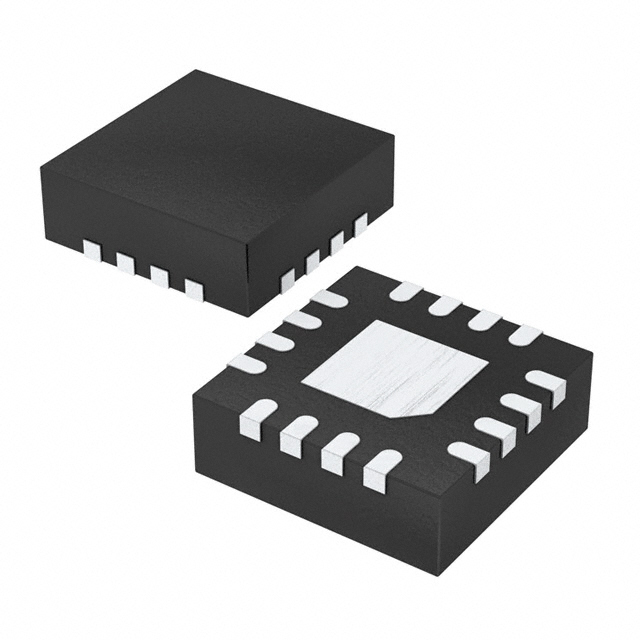MCP4231T-103E/ML
Introduction
The MCP4231T-103E/ML is a digital potentiometer belonging to the category of integrated circuits. It is commonly used in electronic devices to provide variable resistance and control voltage levels. This entry provides an overview of the basic information, specifications, detailed pin configuration, functional features, advantages and disadvantages, working principles, application field plans, and alternative models of the MCP4231T-103E/ML.
Basic Information Overview
- Category: Integrated Circuits
- Use: Provides variable resistance and controls voltage levels in electronic devices
- Characteristics: Digital potentiometer, programmable, non-volatile memory
- Package: TSSOP (Thin Shrink Small Outline Package)
- Essence: Provides a compact and versatile solution for analog signal control
- Packaging/Quantity: Tape and Reel, 2500 units per reel
Specifications
- Resolution: 7-bit
- Interface: SPI (Serial Peripheral Interface)
- Operating Voltage: 2.7V to 5.5V
- Temperature Range: -40°C to +125°C
- Endurance: 1,000,000 write cycles
- Wiper Current: ±1mA
Detailed Pin Configuration
The MCP4231T-103E/ML has a total of 14 pins: 1. A terminal 2. B terminal 3. W terminal 4. VSS (Ground) 5. CS (Chip Select) 6. SCK (Serial Clock) 7. SI (Serial Input) 8. SO (Serial Output) 9. VDD (Power Supply) 10. Terminal A0 11. Terminal B0 12. Terminal W0 13. Terminal W1 14. Terminal B1
Functional Features
- Non-volatile memory for wiper settings
- Low power consumption
- Wide operating voltage range
- Programmable resistance value
- SPI interface for communication
Advantages and Disadvantages
Advantages
- Compact size
- Versatile programmable resistance
- Non-volatile memory
- Low power consumption
Disadvantages
- Limited resolution (7-bit)
Working Principles
The MCP4231T-103E/ML operates by digitally controlling the resistance between its terminals using the SPI interface. The non-volatile memory ensures that the wiper settings are retained even when the power is removed, providing consistent performance across power cycles.
Detailed Application Field Plans
The MCP4231T-103E/ML finds applications in various fields such as: - Audio equipment: Volume control, tone adjustment - Instrumentation: Calibration, signal conditioning - Industrial automation: Variable speed drives, motor control - Consumer electronics: Display brightness control, power management
Detailed and Complete Alternative Models
Some alternative models to the MCP4231T-103E/ML include: - MCP4131T-103E/ML: 7-bit digital potentiometer with similar specifications - AD8403ARZ1: 8-bit digital potentiometer with extended resolution - MAX5481EUD+: Low-power 10-bit digital potentiometer
In conclusion, the MCP4231T-103E/ML digital potentiometer offers a compact and versatile solution for analog signal control in various electronic devices. Its programmable nature, non-volatile memory, and wide operating voltage range make it suitable for diverse applications in different industries.
Word Count: 477
قم بإدراج 10 أسئلة وإجابات شائعة تتعلق بتطبيق MCP4231T-103E/ML في الحلول التقنية
What is the MCP4231T-103E/ML?
- The MCP4231T-103E/ML is a digital potentiometer that can be used to digitally control resistance in various technical solutions.
What is the typical application of MCP4231T-103E/ML?
- The MCP4231T-103E/ML is commonly used in applications where precise resistance adjustments are required, such as in audio equipment, instrumentation, and industrial control systems.
What is the resolution of MCP4231T-103E/ML?
- The MCP4231T-103E/ML has a resolution of 7 bits, allowing for 128 wiper positions for fine-grained control.
How is MCP4231T-103E/ML controlled?
- The MCP4231T-103E/ML can be controlled using a simple SPI interface, making it easy to integrate into existing digital control systems.
What is the voltage range of MCP4231T-103E/ML?
- The MCP4231T-103E/ML operates within a voltage range of 2.7V to 5.5V, making it suitable for a wide variety of applications.
Can MCP4231T-103E/ML be used in automotive applications?
- Yes, the MCP4231T-103E/ML is suitable for automotive applications, provided that the operating conditions and temperature ranges are within its specified limits.
Is MCP4231T-103E/ML suitable for battery-powered devices?
- Yes, the low power consumption and wide voltage range make MCP4231T-103E/ML well-suited for battery-powered devices.
Does MCP4231T-103E/ML have non-volatile memory?
- Yes, the MCP4231T-103E/ML features non-volatile memory, allowing it to retain its settings even when powered off.
What are the key features of MCP4231T-103E/ML?
- Some key features of MCP4231T-103E/ML include low power consumption, small form factor, and high reliability.
Where can I find more detailed information about using MCP4231T-103E/ML in technical solutions?
- For more detailed information, you can refer to the datasheet and application notes provided by the manufacturer.


